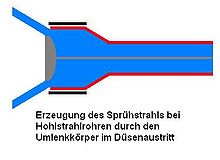Spray jet
In contrast to the full jet, a spray jet is the release of a substance in an atomized and surface-covering form. For this reason, spray jets are used for example for irrigation in agriculture, in the paint shop or in fire fighting by the fire brigade .
Spray jet when fighting fire
Main effect
The extinguishing effect of the water (through cooling) is supported by atomization of the water, since the surface effect on the seat of the fire of the spray jet is more effective with the same amount of water than with a bundled water jet (see full jet ).
Usage
The spray jet is mostly used to extinguish (by cooling) fires of fire class A (solid, embers forming substances).
The spray jet can be used to a limited extent with fire class B (flammable liquids or substances that become liquid) if it can be guaranteed that the effective area of the spray jet can "cover" the entire area of combustion (flame formation). The extinguishing effect is based on the oxygen- displacing property of the "atomized" water. Furthermore, care must be taken to ensure that flammable liquids do not overflow in containers, as water is heavier than most flammable liquids. In this case, the water used has no extinguishing effect on the flame because it sinks under the flammable liquid due to its higher density. A dangerous boilover can then be the result.
In exceptional cases, the spray jet (usually in combination with the full jet) is used to support fires of fire class C (flame fires involving gases). Gas fires are not extinguished - the main goal is to prevent the gas from escaping (for example by closing a cylinder valve) in order to remove the fuel from the fire and to avoid subsequent reignitions. The spray jet is only used to throw down the flames so that safe access to the fuel source is possible, the burning object (for example a gas tank) can be cooled or nearby objects can be shielded.
The method described is used to precipitate dangerous substances and vapors in order to prevent them from spreading or to create better access for emergency services. The wastewater may have to be collected, treated or disposed of separately here.
Extinguishing devices (extract)
- Multi-purpose nozzles BM, CM, DM (switchable from full to spray jet)
- Hollow jet pipes B and C
- Extinguishing lances
- Sprinkler systems
Advantages and disadvantages
- Advantages:
- The spray jet has a better surface effect than the full jet
- Usually less water damage than a full jet
- Can be used at a safety distance of one meter in the event of fire in connection with low-voltage systems with a CM nozzle
- Can be used at a safety distance of five meters in the event of fire in connection with high-voltage systems with a CM radiant tube
- Disadvantage:
- Smaller throwing distance of the spray jet compared to a full jet (around five meters with CM nozzle)
- Low impact force and thus lower penetration depth into the fire material
- High risk of scalding from water vapor in closed rooms due to the short distance and better efficiency between the water and the burning material
literature
- Lothar Schott, Manfred Ritter: Fire Brigade Basic Course FwDV 2 . 20th edition. Wenzel-Verlag, Marburg 2018, ISBN 978-3-88293-220-1 .

